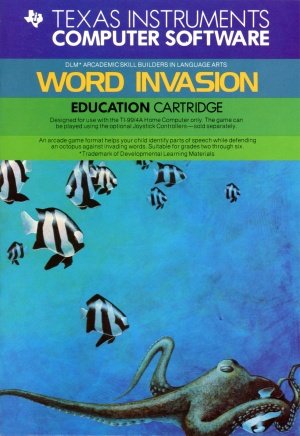Word Invasion
| Word Invasion | |
|---|---|
 Word Invasino Manual (Front Cover) [1] | |
| Publisher(s) | Developmental Learning Materials (DLM) |
| Original Retail Price | $39.95 (USD) |
| Programmer(s) | Dan Rockers |
| Part# | PHM 3169 |
| Format(s) | Solid State SoftwareTM Command Module |
| Release | 1983 (4th Quarter) |
| Genre(s) | Educational, Language Arts |
Contents
Gameplay
Advertising Blurbs
Front of Manual
An arcade format helps your child identify parts of speech while defending an octopus against invading words. Suitable for grades two through six.
Triton Catalog - Spring 1984
Fast action and colorful graphics teach the 6 major parts of speech in an arcade-game format. A friendly alien octopus must protect her underwater territory from a screen full of invading words. Her weapon: a magic ring that moves from tentacle to tentacle, firing at words. Builds Grammar skills. (Wired Remote Controllers recommended.)
Manual
Introducing the ARCADEMICTM SKILL BUILDERS IN LANGUAGE ARTS Series
The ARCADEMICTM SKILL BUILDERS IN LANGUAGE ARTS series was created by Developmental Learning Materials, Jerry Chaffin, Bill Maxwell, and Barbara Thompson. The ARCADEMIC approach uses an arcade game format, colorful graphics, and lively action to create an exciting atmosphere for practicing important learning skills. ARCADEMIC programs provide for the educational needs of individual learners. They allow children to develop skills before progressing to the next level of difficulty. These programs combine learning with fun.
The ARCADEMICTM approach to learning is based on these principles:
- Persistence and Involvement
- Arcade games are fun and exciting, and no one has to encourage a child to play. When applied to learning, the arcade game format motivates children to persist and to remain involved in the subject.
- Success in Learning
- Arcade games start players at a level above their skill, producing high rates of error. Players do not view the errors as failure, but as a challenge to improve. The ARCADEMIC approach also encourages improvement by
providing a game with preset options. This preset version is played at a rapid speed and at an advanced level of difficulty.
- High Rate of Learning
- The arcade game format encourages concentration because it requires fast response in a short period of time.
- Evidence of Improvement
- The arcade game format provides immediate feedback. Players know instantly whether their answer is correct. There is no limit on improvement. Players can make as high a score as their skills permit. They can see their scores as they play. Players know immediately how well they are doing.
- Individual Needs
- The ARCADEMIC approach encourages involvement by allowing selection of many features to fit individual needs. Players can select such features as speed of play, level of difficulty, and the time limit of the game.
